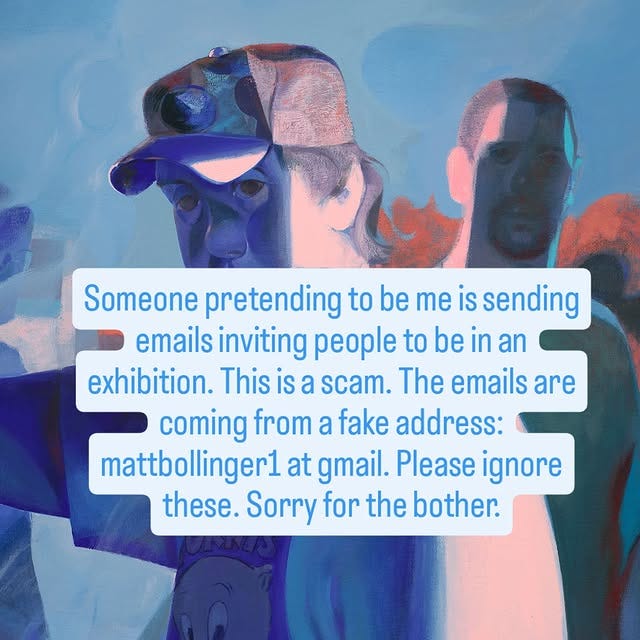I have an idea for a completely separate newsletter called “It’s a scam!” where, each week, I share a story of someone who got scammed and the mechanics of it1.
The newsletter would raise awareness around sneaky tactics and prevalent cons, providing a platform to strip away the stigma of being scammed. I hate scams! As the economy and state of the world become shakier by the day, it feels like fraud has only increased. The art world is not immune.
Last week, The New York Times published an article about a uniquely odd art scam titled “She Thought Lady Gaga Bought Her Art. Then Things Got Strange.” The goal wasn’t to scam the artist out of money (the person paid $55k for the painting). Instead, it used impersonation to gain access to a sought-after young artist. This tells you how truly wild the art world is. Here’s a gift link to the story.
I have so many unanswered questions! Has the person who impersonated Lady Gaga done this before to gain access to other paintings? Is the end goal to simply flip the work for profit? Or is there also a desire for power? After being told you can’t buy an artwork since there’s a waitlist, you think: nobody tells me no! It’s a very childish reaction.
In the article, Emma Webster mentions that, in retrospect, there were red flags she ignored. This is usually the case with scams. They use emotions (positive or negative!) to push your doubts away.
A few years ago, I wrote a newsletter about a common art scam that begins with an email from a “collector” interested in your work, and results in them sending a cheque for more than the painting is worth, asking you to return the difference. Then, the cheque bounces, and you’re out the money.
I think it’s an important article to read and share with an artist in your life. ⬇️⬇️⬇️
This was from three years ago, and the scams are now more sophisticated. I’ve heard of emails being sent from “Peter Doig” or top Sotheby's employees with compliments or noting interest. The other day, Matt Bollinger posted on Instagram that there’s a scam going on that involves being invited to a group exhibition. I have to assume that down the line, they ask you to pay to participate.
I don’t know the mechanics of these new scams, but I do know artists should be very careful who they deal with and engage with a healthy dose of skepticism.
Three tips when looking out for art scams:
Trust your gut. If something doesn’t feel right, it probably isn’t.
Get a second opinion. Ask a friend to look over the email for you and ask what they think. You can email ME and ask if you’re ever unsure!
Do not send money to someone you do not know.
Initially, I was going to have a paywalled section of this email (as part of the ongoing Artist Relations series, which shares practical information for artists) on why and how to set up a Google Alert. Because of how Substack is set up, that would take away the ability for all readers to comment on the post. Since it’s important to have conversations around scams, I’ve made this post free. I’ll send out a separate newsletter tomorrow to paid subscribers.
Have you noticed any other art-related scams? Do you have a tip for avoiding scams? Share your story below.
I don’t have the time or the resources to write this newsletter, but I think it’s a great idea. Feel free to take it!






But yes, would gladly read your articles on art scams Tatum!
If a superstar like, say, Elton John emailed me with an offer like that via a gmail address I’m pretty sure my BS detector would start beeping!